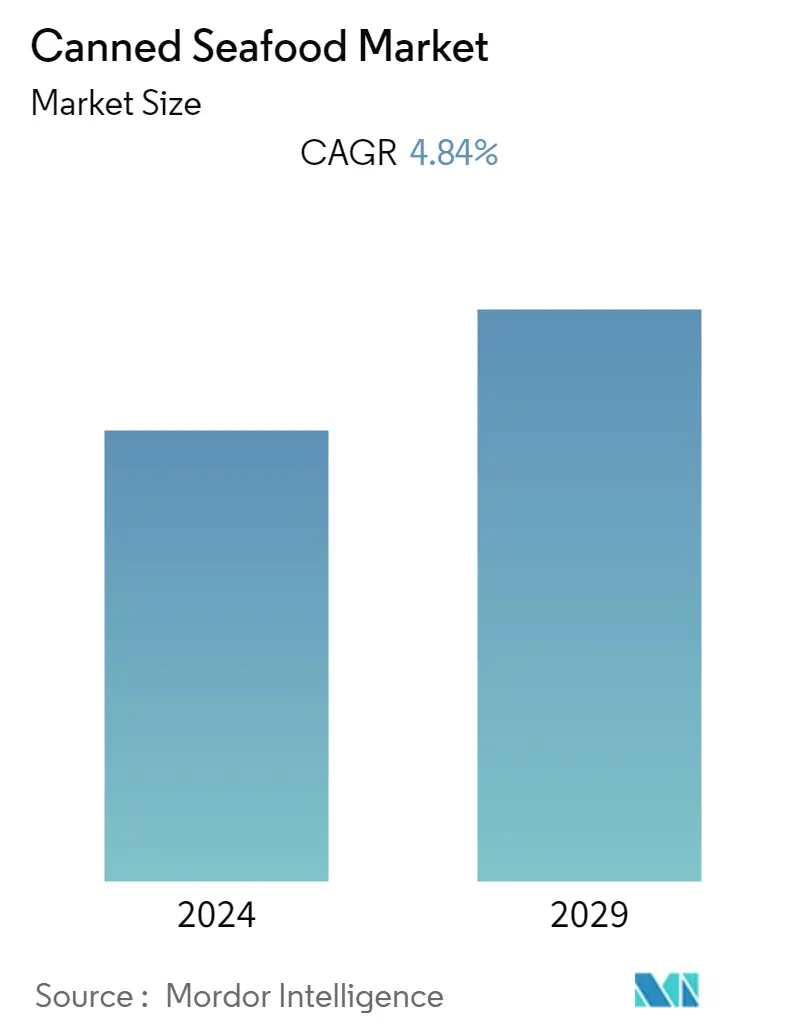Market Size of Canned Seafood Industry

| Study Period | 2018 - 2029 |
| Base Year For Estimation | 2023 |
| CAGR | 4.84 % |
| Fastest Growing Market | South America |
| Largest Market | Europe |
| Market Concentration | Low |
Major Players
*Disclaimer: Major Players sorted in no particular order |
Canned Seafood Market Analysis
The Canned Seafood Market size is expected to grow from USD 28,155.98 million in 2023 to USD 35,662 million by 2028, at a CAGR of 4.84% during the forecast period.
The canned seafood market is majorly driven by the growing demand for ready-to-cook food products and the innovations in canning technologies, which have led to the introduction of diverse products in the market and ensured a bigger consumer base. Furthermore, developing value-added seafood products is another strategy key players adopt to cater to the increased demand in the market. For instance, Pacific Seafood offers a value-added line of canned, frozen, and seasoned raw warm water shrimp infused with whey to enhance the potassium and calcium contents of the product.
Similarly, the sale of canned seafood products, particularly canned tuna, increased as the long shelf life of such products appealed to consumers subjected to home quarantines, regulatory measures restricting ease of movement, and other impacts of the COVID-19 pandemic. The rising awareness about the health benefits offered by canned seafood products is increasing the growth of the canned seafood market. Canned seafood is an excellent source of omega-3 fatty acids, which are important for overall health and well-being. The demand for conspicuous and exotic food items is on the rise as a result of the rising purchasing power of consumers. Therefore, the aforementioned factors are expected to fuel the growth of the canned seafood market over the forecast period.
Canned Seafood Industry Segmentation
Canned seafood is processed food that has been heated and sealed in an airtight container, such as a sealed tin can. The canned seafood market is segmented by type, distribution channel, and geography. By type, the market is segmented into canned fish, canned shrimp, canned prawns, and other types. Canned fish is further sub-segmented into tuna, salmon, sardines, and mackerel. By distribution channel, the market is segmented into supermarkets/hypermarkets, convenience stores, online retail stores, and other distribution channels. It provides an analysis of emerging and established economies across the world, comprising North America, Europe, Asia-Pacific, South America, and the Middle East and Africa. For each segment, the market sizing and forecasts have been done on the basis of value in (USD million).
| Type | ||||||
| ||||||
| Canned Shrimp | ||||||
| Canned Prawns | ||||||
| Other Types |
| Distribution Channel | |
| Supermarkets/Hypermarkets | |
| Convenience Stores | |
| Online Retail Stores | |
| Other Distribution Channels |
| Geography | |||||||||
| |||||||||
| |||||||||
| |||||||||
| |||||||||
|
Canned Seafood Market Size Summary
The canned seafood market is experiencing significant growth, driven by the increasing demand for ready-to-cook food products and advancements in canning technologies. These innovations have expanded the variety of products available, attracting a broader consumer base. The market is further bolstered by the development of value-added seafood products, such as those offered by Pacific Seafood, which enhance nutritional content. The COVID-19 pandemic has also played a role in boosting sales, as the long shelf life of canned seafood products like tuna became appealing during periods of home quarantine and movement restrictions. The health benefits of canned seafood, particularly its omega-3 fatty acid content, are contributing to its rising popularity, alongside a growing consumer interest in exotic food items driven by increased purchasing power.
Key factors propelling the canned seafood market include convenience, rising disposable incomes, and demographic shifts such as an increasing number of working women. Lifestyle changes and higher food expenditure are leading to dietary transitions, with more consumers opting for animal-sourced foods and convenience products like canned seafood. The sustainability of canned seafood, with metal packaging offering effective preservation and recyclability, also supports market growth. The presence of major market players and regional demand for ready-to-eat meals further drive the industry. Companies are investing in product development and sustainable practices to meet the dynamic needs of consumers, with strategic alliances and innovations in product offerings enhancing their market presence.
Canned Seafood Market Size - Table of Contents
-
1. MARKET DYNAMICS
-
1.1 Market Drivers
-
1.2 Market Restraints
-
1.3 Porter's Five Forces Analysis
-
1.3.1 Threat of New Entrants
-
1.3.2 Bargaining Power of Buyers/Consumers
-
1.3.3 Bargaining Power of Suppliers
-
1.3.4 Threat of Substitute Products
-
1.3.5 Intensity of Competitive Rivalry
-
-
-
2. MARKET SEGMENTATION
-
2.1 Type
-
2.1.1 Canned Fish
-
2.1.1.1 Tuna
-
2.1.1.2 Salmon
-
2.1.1.3 Sardines
-
2.1.1.4 Mackerel
-
-
2.1.2 Canned Shrimp
-
2.1.3 Canned Prawns
-
2.1.4 Other Types
-
-
2.2 Distribution Channel
-
2.2.1 Supermarkets/Hypermarkets
-
2.2.2 Convenience Stores
-
2.2.3 Online Retail Stores
-
2.2.4 Other Distribution Channels
-
-
2.3 Geography
-
2.3.1 North America
-
2.3.1.1 United States
-
2.3.1.2 Canada
-
2.3.1.3 Mexico
-
2.3.1.4 Rest of North America
-
-
2.3.2 Europe
-
2.3.2.1 United Kingdom
-
2.3.2.2 Germany
-
2.3.2.3 Spain
-
2.3.2.4 France
-
2.3.2.5 Italy
-
2.3.2.6 Russia
-
2.3.2.7 Rest of Europe
-
-
2.3.3 Asia-Pacific
-
2.3.3.1 China
-
2.3.3.2 Japan
-
2.3.3.3 India
-
2.3.3.4 Australia
-
2.3.3.5 Rest of Asia-Pacific
-
-
2.3.4 South America
-
2.3.4.1 Brazil
-
2.3.4.2 Argentina
-
2.3.4.3 Rest of South America
-
-
2.3.5 Middle East and Africa
-
2.3.5.1 United Arab Emirates
-
2.3.5.2 South Africa
-
2.3.5.3 Rest of Middle East and Africa
-
-
-
Canned Seafood Market Size FAQs
What is the current Canned Seafood Market size?
The Canned Seafood Market is projected to register a CAGR of 4.84% during the forecast period (2024-2029)
Who are the key players in Canned Seafood Market?
Thai Union Group , Trident Seafoods Corporation, Maruha Nichiro Corporation, Dongwon Enterprise Co., Ltd. and FCF Co. Ltd (Bumble Bee Foods LLC) are the major companies operating in the Canned Seafood Market.

